ENTER YOUR EMAIL TO RECEIVE OUR WEEKLY NEWSLETTER
The Promiscuous Gardener
Riffing on the sly and guileful beauty of roses
By George Blecher
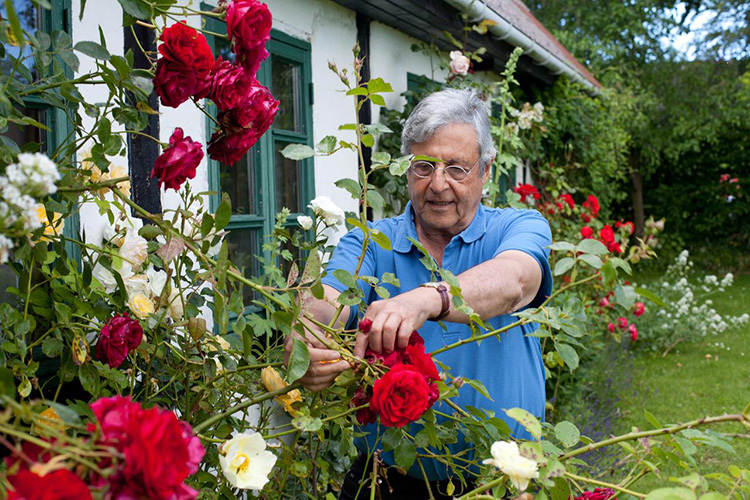
The author, no doubt about to get thorn-scratched as he tends the Sympathie roses at his cottage in Denmark.
. . . . . . . . . . . . .
July 30, 2022
I find myself wandering around the garden. I don’t exactly know how I got here; though I gave up smoking weed years ago, I must be in some sort of trance. When the tension of sitting at my desk gets too much for me, someone with a cool hand seems to lead me outside. The cottage is so narrow that being inside isn’t much more than an enclosed version of being outside. When the air hits my skin, I feel light enough to fly.
I’m not sure what I do in this trance. At some point my left thumb and first two fingers feel sore, which must mean that I spend a lot of time snapping dead-heads off rose bushes. Seeing a patch of goutweed (in Danish the word is skvalderkaal—sounding like a sneer), which can choke out a flower bed in a matter of days, I fall to my knees and start digging it out—even though I know I can’t kill it, only slow its spread. It’s supposedly full of vitamins; a few cynical Danes apparently bake it into bread. A Viking version of eating your enemy’s heart?
Pants caked with mud, I keep drifting around the garden. By June it is a tangle of vines, some of which grow so wantonly that they look like they could swallow up the whole cottage. Some rose shoots can grow five or six feet in a few months.
One of the more spectacular roses grows right by the front door. Back in the Riverdale section of the Bronx, where I grew up, that’s the spot where my father tried hardest to grow his roses. Surrounding our front door was a candy-red climber with an apple scent and tight little blossoms whose petals turned dark and singed-looking after a day or two of sun, and soggy the minute water touched them. The plant itself looked anemic: summers in the Bronx were too hot, the air too humid, the Japanese beetles too ravenous and plentiful for roses. My father pushed back his rain-shrunken fedora and clucked his tongue: how the hell do you get these plants to blossom their hearts out?
He failed with roses, though he never stopped trying. I grow them through little effort of my own; in Denmark’s latitude, they grow like weeds. Everybody in the village has a spectacular garden—roses, lilacs, peonies, hydrangea, foxgloves, columbine, clematis, delphiniums, fruit trees, towering buddleia, and beauty bushes. Even in summer the Danish climate is cool to cold at night—which roses adore—and in the daytime skiftende vejr (changing weather) or nowadays the more clinical ustabil vejr (unstable weather), that seesaws between sun and rain so often that the plants get doses of each every few hours. In twenty-five years I’ve seen Japanese beetles only twice, and felt the same pit in my stomach that my father must have felt when he caught the glint of their sickening green/gold carapaces.
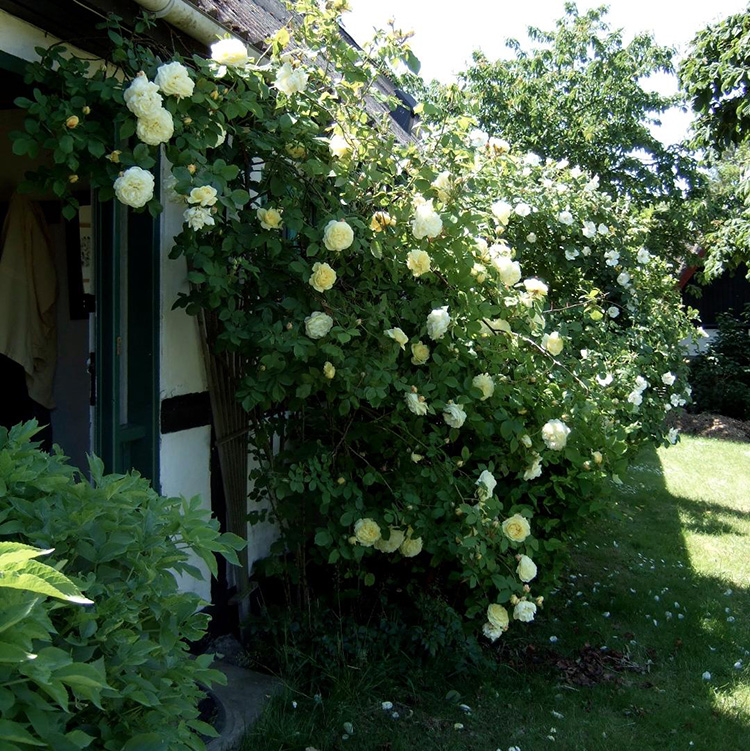
Growing as large as a man’s hand, the yellow roses at the front door beckon with the seductive scent of musk.
. . . . . . . . . . . . .
My sister gave us a book about historic roses, most of which bloom only once a summer in an ecstatic burst. We ordered forty different kinds from Britain, Germany, and a nursery in Denmark an hour away. They cost the equivalent of $10 apiece. That seemed impossibly cheap: how can you even set a price on living protoplasm that could survive in your garden for the rest of your life? I planted day and night. Since there wasn’t much night, I could keep going to at least 10:30. That first summer the weather was uncharacteristically dry, the ground rock-hard. The clayey parts of the garden—soil changes millimeter by millimeter, a universe of micro-climates—were so impenetrable I had to hose them down and hack away with a spade and an axe. I dug deeper than I needed to. I made giant pits where rose roots would be free to grow and spread, and I filled the holes with peat, walnut shells, planting soil, NPK, aged horse manure—the best gourmet meal that the nursery could supply. I would make the roses grow. I would outdo my father. I would make my family proud. I would fill up the empty holes.
The rose that grows over the front door of the cottage has yellow blossoms as big as a man’s hand. Since it isn’t one of the plants we ordered from a nursery, I have no idea of its real name. But it is as vigorous as a body builder, without the slightest mold or hint of black spot, and lanky vines with light green leaves that hang down like tresses and then turn upward, offering fat yellow buds in a pea-green casing. The blossoms start out canary yellow with wide, almost papery blooms, but change like the aging of a blond woman to an almost brown tint to paler yellow and finally to gray-white: a sped-up version of time itself. The scent is Old Rose musk—sharper and deeper than the fruity aroma of modern roses—a smell of sex rather than supermarket.
This no-name rose is so productive—50-70 blossoms from the middle of June to the second week in July—that one could almost ignore all the others.
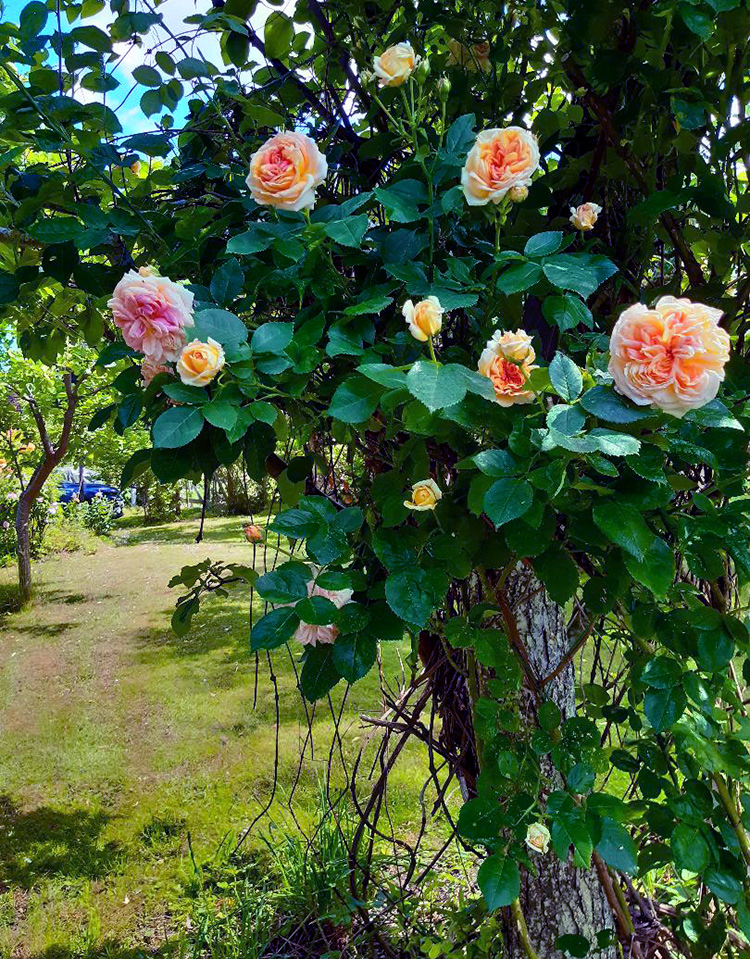
Alchymist roses receive the author’s rating of gorgeous but clumsy. (Well, clumsy can be charming.)
. . . . . . . . . . . . .
But I am the most promiscuous of gardeners.
To me, roses have gender. Most are female, but not all. Some look and even smell masculine; no doubt their names play a part. Others are asexual (like the sturdily bourgeois Rose de Rescht), or polysexual, pansexual, metasexual. But sex is only one of their animal qualities. After decades of wandering around the garden, I attribute a variety of traits to roses that may or may not exist in their vegetable souls. All the traits seem perfectly reasonable to me.
Some roses are stupider than others. I’m thinking of the youthful but indecisive Henri Martin, the gorgeous but clumsy Alchymist, the hyperactive climber Albertine. Some are more mature—the neurasthenic Boule de Neige, the seductive but melancholy Étoile de Hollande—while others are pure innocence: Celestial, a gawky, cheerful pink Alba rose that seems almost to have a sense of humor; or the nubile modern hybrid Gertrude Jekyll with the most powerful Old Rose aroma in the garden, but a curiously virginal flower.
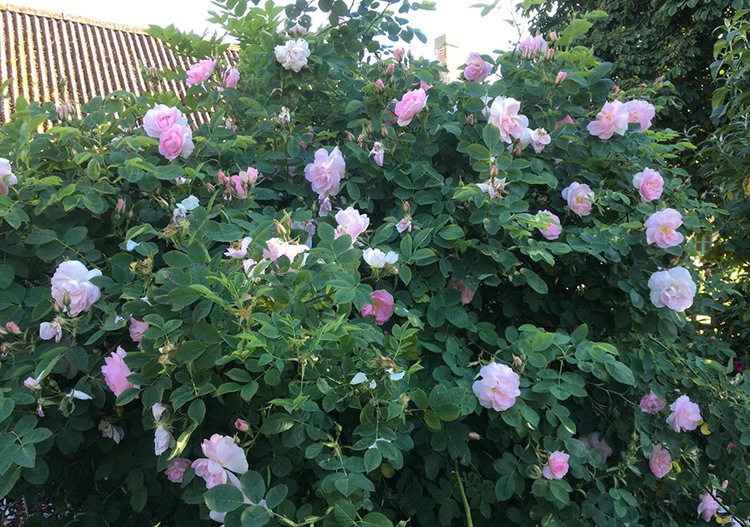
Gawky and innocent, the pink Celestial rose almost comes across with a sense of humor.
. . . . . . . . . . . . .
I leave out the innate savagery of the rose. These are ferocious plants! No other domesticated plant defends itself so fiercely. The older species that haven’t been tamed by overbreeding take the offensive. Spreading quicker than most weeds, they send out exploratory suckers on underground expeditions, surfacing ten or twenty feet from their source. The thorns are erotic; the designers of dildos and whips must use rose thorns for inspiration. After an afternoon of working among the bushes, my arms are bloodied up to my shoulders—cat-like scratches nearly a foot long, with paths of bloody beads that sting for days and leave scars for months. But I don’t notice a thing. I’m too caught up in the task. I don’t mind being scratched. I like it.
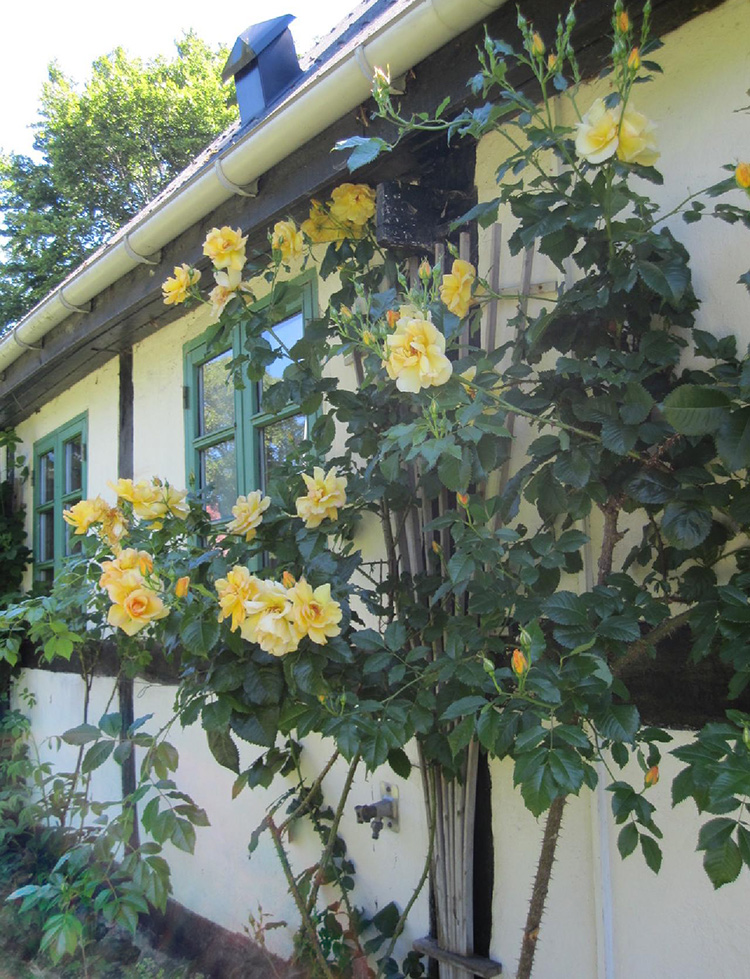
The modest yellow Maigold rose, a good and solid citizen, exudes an earthy rather than seductive scent.
. . . . . . . . . . . . .
A few yards from the front door toward the middle of the house is another climber, a German rose called Maigold, with a yellow blossom but this time an eggy, rusty yellow, a modest, almost sepia color. If the no-name blossom moves from adolescence to old age, Maigold starts out in middle age and stays there. Everything about it suggests solidity, good citizenship. The several canes are as thick as a child’s arm, and covered with bristle-like thorns that stab deep, and cling. The petals of the blossom are wide, forthright, magnolia-like, and arranged in an open pattern of what the flower catalogues call “double”—somewhere between the simplicity of wild roses and the rosette form of the more complicated flowers. Maigold’s scent is earthy rather than seductive, like Beaujolais, with more than a hint of manure.
I don’t swoon before this rose; it makes me stand up straighter. A stalwart in the garden, it is so dependable that it looks like it could prop up the house all by itself. But in a sense, its dependability implies its obverse. Could it be that at its biological/emotional heart is a vulnerability that it bravely conceals? At least grant me the possibility.
Maybe a rose garden has as much to do with love as desire.
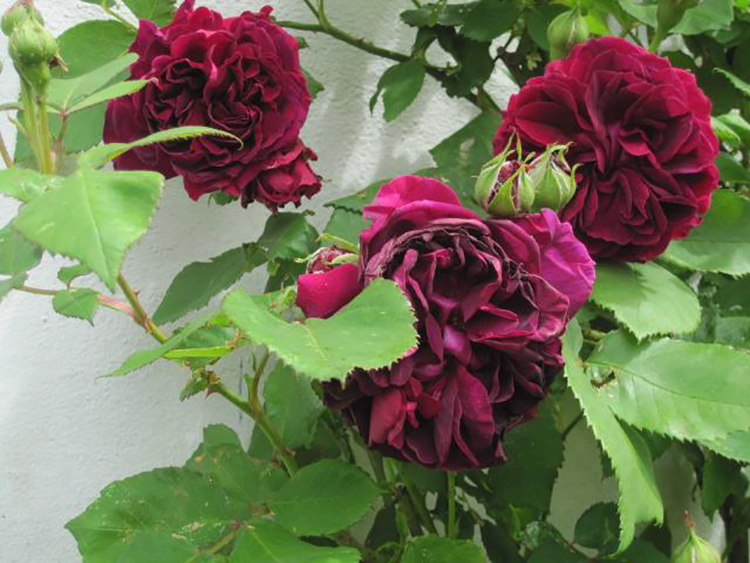
The Alfred Colomb rose, deemed decidedly male by the author, ensnares with its unique twists and turns and its velvety, cherry-like scent.
. . . . . . . . . . . . .
On the stormy west wall is the most beautiful rose in the garden, and the most masculine. I know from the way women react. When they notice it, their expressions change. They approach on tiptoe. If they see me watching, they blush and stand in place until I stop staring. Then they start again, reaching out to touch one of its blossoms, cradling it as though their touch will arouse it.
Alfred Colomb stands flat against the wall, though it is not officially a climber; rather than extending arms that must be tied and pinned back, it sends up from the ground five or six determined canes that hardly droop. It is not a shapely plant but isn’t stunted either, the way modern roses can be when they’re bred to lift their hypertrophic blossoms on spindly stalks. Alfred Colomb’s flowers aren’t like any others, though it is hard to say exactly why. In a 1913 flower catalogue, I found this purple prose: “There are few roses where every blossom is as perfect as those of Alfred Colomb. There are none whose fragrance is sweeter.” Banal, but true. The blossom’s color is at the nexus of crimson and purple, turning to red/blue/black in the curves and recesses of the petals. The flower is perfect, yet not in the sense of symmetrical. In its many folds, twists and turns, it is mysterious, suggesting a sensuality that never cloys. When a few petals start curling, turning gray or shriveled, the blemishes seem like personal insults. The scent is Old Rose, cherry-like but more layered, as if velvet had a scent.
The fact that Alfred Colomb seems male makes it even more erotic, not only because of its seductiveness but because it is my rival. It has a sensuality that I am jealous of; if I study it carefully, maybe I can learn something. Indoors, it works best in a vase with just a few other roses—white and orange ones like Buff Beauty and Blanc Double de Coubert. Not only does it become the dark center of the bouquet, but it seems to gather all the other colors around it and make them more intense.
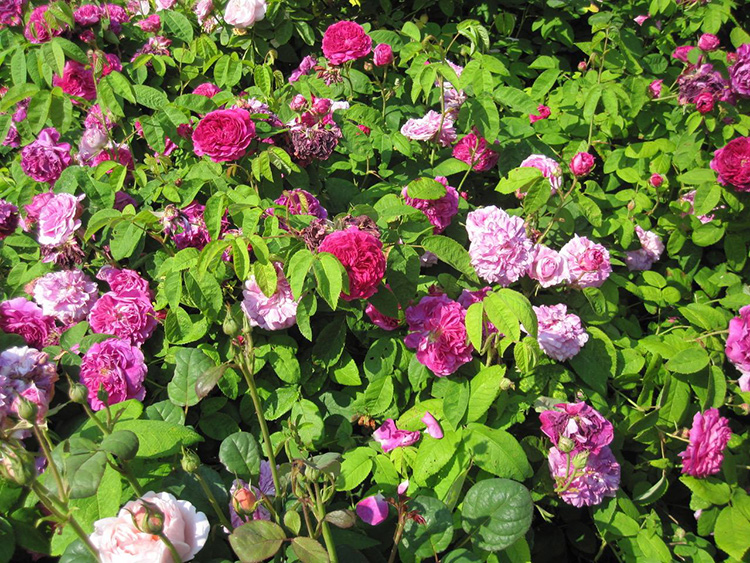
Born to spread, mingled Alba and Gallica roses are rated as pure-life energy.
. . . . . . . . . . . . .
One flower bed in the garden is made up of very Old Roses—Albas and Gallicas that originated in the Middle East a thousand years ago. The Gallicas crawl rather than seek the sun. Most of the blossoms are small, rosette-shaped, brilliantly bloody shades of red. Over the years the plants have become so intertwined with one another I can’t tell them apart. They’re named after people lost to history but who survive in this mutated form: Charles de Mills, Jenny Duvall, President de Sèze, Keene. Their colors compete like slabs of meat behind butcher’s glass. They are not seductive or cultured or even beautiful, but pure life-energy; their single goal is to spread.
At the foot of the garden is the outlaw bed. For some reason the dirt here is filled with a devil’s array of weeds and invasive plants—dandelions, nettles, wild blackberries, lilacs sending suckers under the ground, nettles, goutweed, many others that I don’t know the names of but recognize as the enemy. The roots of many young rose plants have been strangled here. I tried fertilizer, a trailer-full of new soil; nothing worked. It is also a place for black plants, or as black as roses can get—Tuscany Superb, the crimson of the Austin hybrid Shakespeare, Reine des Violettes, black hollyhocks, and Siberian globe thistles that look like gray/blue golf balls studded with nails. They have no relation to one another except that they are all survivors, tattooed musclemen swaggering around a prison-yard. This patch of garden is exciting, dangerous—a collection of outcasts. But why shouldn’t there be a place in a garden for the treacherous sides of nature?
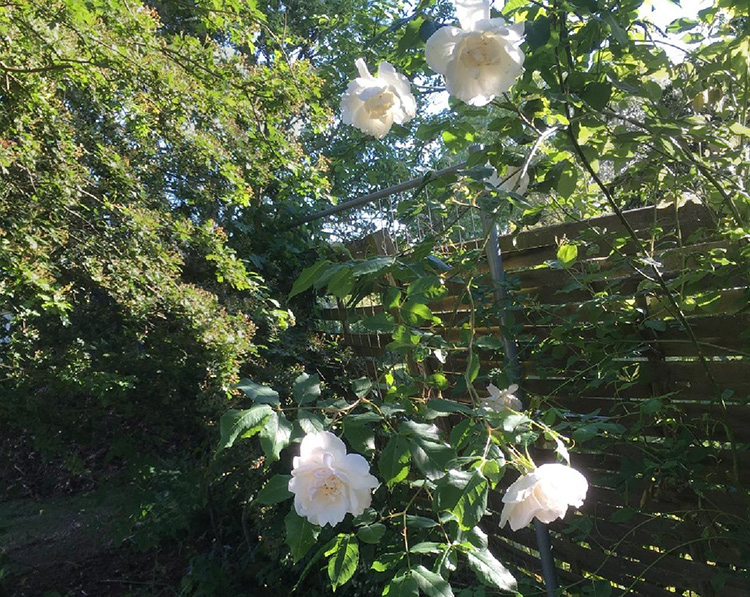
Floppy Mme Alfred Carrière reminds the author of a tall, distracted woman in a white dress—Virginia Woolf, he proposes.
. . . . . . . . . . . . .
There is at least one more provocative rose in the garden. In an obscure corner, overshadowed by a white hawthorn tree, the kind that was in Proust’s grandmother’s garden, grows a white climbing rose, Mme Alfred Carrière. It has a Pre-Raphaelite floppiness that no amount of fertilizer can firm up. The blossoms look disheveled—white with a hint of pink blush, like a woman who has spent too much time indoors. The plant in my garden starts to arch at a height of about seven feet, where it catches the western light over a fence. Standing by it feels like standing next to a tall, distracted woman in a white dress. A Virginia Woolf heroine. Virginia Woolf herself.
Then there are nettles. Everywhere. Every year they come back by the thousands. They look like sheaves of grain, with long rows of seeds on elegantly plumed tassels. They hurt. They sting. Not terribly, but enough to leave red welts that keep the skin tingling for a couple of days: their tea is recommended for everything from dandruff to gout. I yank them up slowly, trying to take care that no rhizome breaks off and remains in the ground. But they belong in the garden as much as I do, more than I do, and seeing them lying in bunches dried and shriveled feels like a form of sadism. Their favorite hangout is of course the compost heap.
But their message is loud and clear: You can keep us in check for a while, but don’t fool yourself: your dream of domination is as temporary as you are.
©2022 George Blecher
. . . . . . . . . . . . .
George Blecher writes for The New York Times and for a number of European publications about American politics and culture. This past year, he has been a fellow at the CUNY Graduate Center’s Writers’ Institute. See georgeblecher.com











